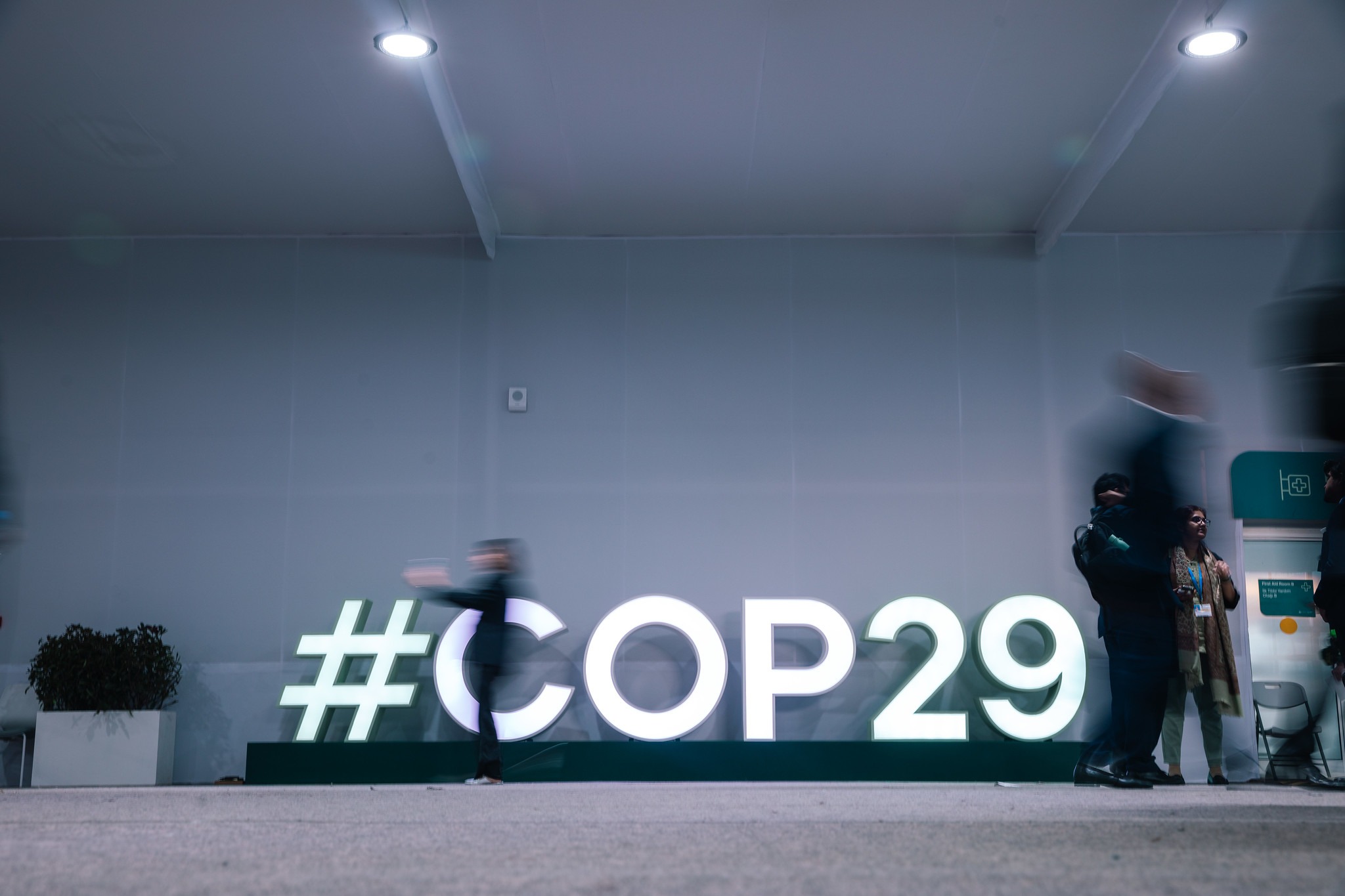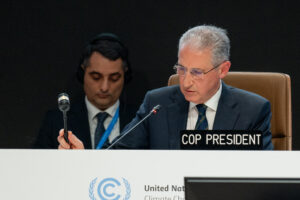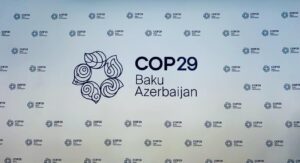It took until 2:40 in the morning on 24 November 2024, a day and a half past the official schedule, for the Parties to reach an agreement on the new climate finance commitments, thus concluding the 29th United Nations Climate Change Conference, COP29.
Among the key outcomes of COP29, the star player is the New Collective Quantified Goal (NCQG), whereby the world pledged to mobilise at least $300 billion per year to help developing countries tackle climate change and its impacts. The final text also speaks of developed countries “taking the lead” in bringing the world to this goal, while developing countries will be able to contribute on a voluntary basis.
The Baku-Belém Roadmap was also included in the agreement, with the aim of fostering international cooperation for the progressive increase of financial resources, from both public and private sources, to be directed to developing countries. The goal of the Roadmap is to reach $1.3 trillion per year in climate finance by 2035.
The results of COP29: not just finance
The NCQG text is only one part of the final document approved at COP29. This package, called the Baku Climate Unity Pact, also includes agreements on mitigation (the reduction of emissions primarily through the energy transition), the Mitigation Work Programme, and one on climate adaptation, the Global Goal on Adaptation. However, fragmentation within the agreement, such as the lack of direct linkage between the climate finance goal and the adaptation goal, weakens the final text.
At COP29, important results were also achieved in the area of carbon markets, with a partial breakthrough on Article 6 of the Paris Agreement, strongly advocated for by the Azerbaijani Presidency. However, the pressure to reach a deal by the end of the proceedings compromised the improvement of transparency and accountability mechanisms, leading many parties to question the actual effectiveness of the mechanism in reducing CO2 emissions.
On the issue of the climate and gender inequality nexus, the Lima Work Programme was adopted, aiming to develop a Gender Action Plan (GAP) for COP30 in Belém.
However, COP29 failed to make progress on other issues, with several discussions postponed to future climate diplomacy meetings. Negotiations on the UAE Dialogue, the agreement made at COP28 in Dubai for transitioning away from fossil fuels, yielded no resolution among the Parties. In particular, no compromises were reached on actions to follow up on last year’s Global Stocktake, nor on the Just Transition Work Programme. Dialogues on these two items will be resumed in Bonn, where preparatory meetings for the next COP traditionally take place in June.
It’s important to recall that the Global Stocktake was a historic achievement at COP28: for the first time, the “transition away from fossil fuels” was discussed. In Baku, however, countries failed to follow through on this commitment, and the necessity of transitioning away from fossil fuels was not explicitly reaffirmed in the final text. During negotiations, several parties refused to adopt an agreement they deemed insufficiently ambitious, hoping that postponing the discussion to 2025 could yield the desired results.
The June 2025 meetings in Bonn will also address finance, particularly the Adaptation Fund and the Loss and Damage Fund (L&D), on which commitments in Baku were insufficient and inconclusive.
Main reactions
The outcomes of COP29 provoked mixed reactions among the Parties. Developing countries expressed strong discontent, deeming the climate finance goal as falling short of their needs. India, shortly after the gavel sounded at the end of COP29, strongly criticised the decision, speaking of “abysmally poor” resources, insufficient to address the enormous challenges posed by climate change. Cuba, Bolivia and Nigeria also expressed dissatisfaction, pointing out that, considering inflation, the $300 billion target is barely three times the previous $100 billion goal reached at COP15 in 2009. The European Union, on the other hand, offered a (moderately) positive reaction, describing the deal as exceptional considering the difficult global political context in which it was reached.
Glass half full or half empty?
The reluctance of developed countries to mobilise financial resources for developing countries risks delaying the transition and economic development (and thus the fight against poverty). However, the fact that the final text, thanks to the Baku-Belém Roadmap, mentions the “trillions” needed for the transition is a positive sign: just three years ago, when discussions on the NCQG began, such a notion was unimaginable. So, there are signs that things are moving, and not only within the UNFCCC: the issue is also becoming central in discussions within international financial and monetary institutions, such as multilateral development banks and the International Development Association (IDA) of the World Bank.
The compromise reached on the NCQG text does not fully ensure support for the transformations the world needs, including the implementation of sufficiently ambitious national strategies to meet the 1.5°C target. However, it represents a solid foundation, not only financially, on which to build effective cooperation in the coming years.
Moreover, the results of Baku were achieved against a backdrop of extreme international political instability, which nonetheless demonstrates a high degree of diplomatic flexibility among countries that, despite starting with often very divergent positions, believed in the UN’s multilateral mechanisms, thus reaffirming their importance.
COP29: making sense of what happened
The achievement of these results at COP29 was also due to the efforts of a small number of countries who, behind the scenes, mediated among the various groups and alliances within the UNFCCC to bridge gaps between positions. Global tensions and the results of the US elections had cast a shadow of pessimism over the outcome of the negotiations, and many felt that the behaviour of the Azerbaijani Presidency of COP29 did not help calm nerves: during the plenary, India described the entire COP29 process as being “stage-managed,” while the Alliance of Small Island States (AOSIS) and several LDCs, feeling their voices were not sufficiently heard, temporarily abandoned the negotiations. The position of developed countries was also not particularly encouraging: throughout the conference, they never proposed a quantified NCQG (in dollars), much to the frustration of the countries of the global South. However, several developing countries took the initiative and became key players. The efforts of Colombia, Kenya, Brazil, China, Barbados (and others) were crucial to the results of COP29; from the global North, the United Kingdom’s commitment also stood out.
Discussions on finances are evolving, but the reluctance of developed countries to provide support is slowing down the transition to sustainable development and poverty eradication. However, three years ago, when the NCQG discussions began, it would have been unimaginable to talk about needs in the trillions. The agreement of all parties, supported by independent assessments, on an aspirational target of trillions of dollars is a major achievement. Signs from outside the UNFCCC (such as MDBs, innovative financing sources, and the reform of the IFA) are also encouraging. However, as developing countries emphasised throughout COP29, access to and the quality of finance remain fundamental issues, and the final NCQG text does not guarantee that public, grant-based financing will be provided by developed countries. It is important, therefore, that the progress made in the discussions before and during COP29 be leveraged in the future, including in the Baku-Belém Roadmap.
The urgency of the effects of climate change is not matched by an adequate level of attention and funding. During their speeches at COP29, leaders repeatedly highlighted the impact of climate change on people, amplifying the demands of their citizens. However, almost no action has been taken to turn these concerns into tangible outcomes that could make a difference. The Adaptation Fund and Loss and Damage Fund received very limited commitments, and most of the agenda items ended with procedural details to be further explored in Bonn.
The Global Stocktake (GST), adopted at COP28, provides a series of responses to the climate crisis, including transitioning away from fossil fuels and halting and reversing deforestation by 2030, but COP29 failed to follow up on these commitments. The final text, in fact, did not include elements that were central to many parties’ interventions at COP29. Many countries highlighted the need for financing to implement the GST, while others tried to draw more attention to specific parts of the document. This ended in disagreement that prevented the adoption of a decision and postponed discussions to 2025.
The goal of keeping global warming below 1.5°C is precarious. All studies, as well as the budget drawn up in 2023 with the GST, show that we are not on track due to insufficient national strategies (NDCs). We now add an unambitious NCQG, which risks creating further distrust among governments, populations and businesses. However, the task ahead is clear: we need to develop ambitious NDCs aligned with the 1.5°C trajectory for COP30. The international community must continue to mobilise based on scientific truths, ensuring that the Intergovernmental Panel on Climate Change (IPCC) continues to guide the work of the Parties and the UN climate process. The Baku-Belém Roadmap, moreover, could prove to be a key tool in addressing the shortcomings of Baku’s NCQG.






